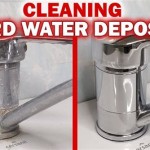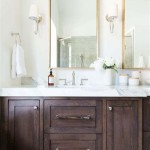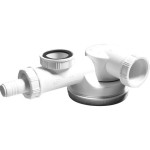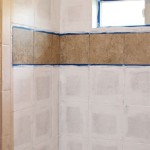How To Chalk Paint Bathroom Cabinets: A Transformation Guide
Chalk paint has become a popular choice for revitalizing furniture and cabinetry, including bathroom cabinets. Its ease of use, excellent adhesion, and matte finish make it an attractive option for updating the look of a bathroom without extensive renovation. This article provides a comprehensive guide on how to chalk paint bathroom cabinets, covering preparation, application, and finishing techniques to achieve a professional-looking result.
Before commencing any painting project, it is crucial to understand the benefits and limitations of using chalk paint in a bathroom setting. Bathrooms are typically humid environments, which can impact the longevity of the paint finish. Proper preparation and sealing are paramount to ensure the chalk paint adheres well and withstands the moisture and temperature fluctuations inherent in bathrooms. This article will detail each stage, offering practical advice to mitigate potential issues and ensure a durable and aesthetically pleasing outcome.
Key Point 1: Preparation – The Foundation for a Successful Chalk Paint Project
Proper preparation is the most critical step in achieving a professional and long-lasting finish when chalk painting bathroom cabinets. The quality of the finished product depends heavily on the thoroughness of this stage. This involves removing cabinet doors and drawers, cleaning the surfaces, and addressing any existing imperfections.
First, remove all hardware, including hinges, knobs, and pulls. Label each piece and store them securely to prevent loss or damage. It is advisable to take photographs of the cabinet configuration before disassembly to facilitate easier reassembly later. Next, detach the cabinet doors and drawers from the cabinet frames. This allows for easier access to all surfaces for painting and prevents drips or runs.
Thoroughly clean all surfaces to be painted. Use a degreasing cleaner to remove any grease, grime, or soap scum. A mixture of warm water and dish soap is often sufficient for general cleaning, but stubborn stains may require a stronger degreaser. Rinse the surfaces with clean water and allow them to dry completely. Residual grease or grime can prevent the chalk paint from adhering properly, leading to peeling or chipping over time.
Inspect the cabinet surfaces for any imperfections, such as scratches, dents, or chips. Fill these imperfections with wood filler and allow it to dry completely according to the manufacturer's instructions. Sand the filled areas smooth using fine-grit sandpaper (220-grit or higher). Sanding ensures that the patch blends seamlessly with the surrounding surface and provides a uniform base for the chalk paint.
While one of the benefits of chalk paint is its ability to adhere to many surfaces without priming, priming is still recommended for bathroom cabinets, especially those made of laminate or with a glossy finish. A high-quality bonding primer will significantly improve the adhesion of the chalk paint and provide a more durable finish. Apply a thin, even coat of primer using a brush or roller, following the manufacturer's instructions. Allow the primer to dry completely before proceeding to the next step.
Protect the surrounding areas by laying down drop cloths or plastic sheeting. Use painter's tape to mask off any areas that should not be painted, such as walls, countertops, or mirrors. This will help to ensure clean lines and prevent unwanted paint splatters.
Key Point 2: Application – Techniques for Achieving a Smooth and Even Chalk Paint Finish
The application of chalk paint requires careful consideration of technique and materials to achieve a desired aesthetic. Selecting the right brush and employing the correct painting method are pivotal for achieving a smooth, even finish. Understanding the nuances of chalk paint and its interactions with various surfaces is also critical.
Choose a high-quality brush specifically designed for chalk paint or a synthetic bristle brush. Natural bristle brushes can leave brushstrokes, while synthetic brushes tend to provide a smoother finish. A brush with angled bristles can be helpful for reaching corners and edges. Alternatively, a foam roller can be used for larger, flat surfaces to minimize brushstrokes.
Before applying the chalk paint, stir it thoroughly to ensure that the pigments are evenly distributed. Do not shake the can, as this can introduce air bubbles. Apply the chalk paint in thin, even coats. Avoid applying too much paint at once, as this can lead to drips and runs. Multiple thin coats are preferable to one thick coat.
Use long, even strokes, following the direction of the wood grain (if applicable). Overlapping each stroke slightly will help to prevent streaks and ensure uniform coverage. If using a brush, avoid pressing too hard, as this can cause the bristles to splay and leave brushstrokes. If using a roller, apply even pressure and roll in a consistent direction.
Allow each coat of chalk paint to dry completely before applying the next coat. Drying times can vary depending on the humidity and temperature, so it is important to consult the manufacturer's instructions. Typically, chalk paint will dry to the touch within 30 minutes to an hour, but allowing it to dry for several hours or overnight is recommended before applying the next coat.
Most chalk paint projects require two to three coats of paint to achieve full coverage and a consistent color. After each coat, inspect the surface for any imperfections or missed spots. Lightly sand the surface with fine-grit sandpaper (400-grit or higher) between coats to remove any imperfections and create a smoother surface for the next coat. Be careful not to sand too aggressively, as this can remove the paint.
For a distressed look, sand the edges and corners of the cabinets after the final coat of paint has dried. Use sandpaper or a sanding block to remove some of the paint and reveal the underlying wood or primer. This creates a worn and aged appearance. The level of distressing can be customized to personal preference.
Key Point 3: Sealing – Protecting the Chalk Paint Finish in a Humid Environment
Sealing chalk-painted bathroom cabinets is essential for protecting the finish from moisture and wear. Bathrooms are inherently humid environments, and unsealed chalk paint is susceptible to water damage, stains, and peeling. Choosing the right sealant and applying it properly will ensure the longevity and durability of the paint finish.
There are several types of sealants that can be used to protect chalk paint, including wax, polyurethane, and chalk paint-specific sealers. Wax provides a soft, matte finish and is easy to apply, but it offers less protection against moisture than polyurethane. Polyurethane is a more durable sealant that provides excellent protection against water damage, but it can yellow over time and may not be ideal for lighter colors. Chalk paint-specific sealers are designed to work specifically with chalk paint and offer a balance of protection and aesthetic appeal.
Before applying the sealant, ensure that the final coat of chalk paint is completely dry. Use a lint-free cloth or a brush designed for applying sealant. Apply a thin, even coat of sealant, following the manufacturer's instructions. Avoid applying too much sealant at once, as this can lead to streaks and drips. For wax application, apply the wax in small sections, working it into the surface with a brush or cloth. Buff the wax to a shine after it has dried.
For polyurethane application, apply the sealant in long, even strokes, following the direction of the grain (if applicable). Allow each coat to dry completely before applying the next coat. Two to three coats of polyurethane are recommended for maximum protection. Lightly sand the surface with fine-grit sandpaper (400-grit or higher) between coats to remove any imperfections and create a smoother surface for the next coat.
Some chalk paint-specific sealers may require specific application techniques or drying times. Always consult the manufacturer's instructions for the best results. Apply multiple thin coats rather than one thick coat to prevent drips and ensure even coverage.
Allow the sealant to cure completely before exposing the cabinets to moisture or humidity. Curing times can vary depending on the type of sealant and the environmental conditions, so it is important to consult the manufacturer's instructions. Typically, sealants will cure completely within 24 to 72 hours.
After the sealant has cured, reattach the hardware and reassemble the cabinet doors and drawers. Ensure that all screws and hinges are tightened securely. Clean any fingerprints or smudges from the finished surface with a soft cloth. Regular cleaning with a mild soap and water solution will help to maintain the appearance of the chalk-painted cabinets.
Consider applying a mildew-resistant additive to the chalk paint or sealant for enhanced protection against mold and mildew growth, especially in high-humidity areas. Regularly inspect the cabinets for any signs of water damage or peeling paint and address any issues promptly to prevent further damage.

Bathroom Vanity Transformation With Diy Chalk Type Paint

Bathroom Vanity Transformation With Diy Chalk Type Paint
Easy Bathroom Cabinet Transformation House Full Of Summer Coastal Home Lifestyle

Painted Bathroom Vanity In Rustoleum Chalked Up Aged Gray Grey Kitchen Cabinets Diy Makeover

Chalk Paint Bathroom Vanity Makeover Remodelaholic
Easy Bathroom Cabinet Transformation House Full Of Summer Coastal Home Lifestyle

Blue Diy Chalk Paint Bathroom Vanity Makeover Abbotts At Home

Honest Review Of My Chalk Painted Bathroom Vanities Sarah Joy

Diy Updated Bathroom Painting Cabinets And Backsplash Tile With Chalk Paint

How To Transform Your Bathroom Vanity
Related Posts







